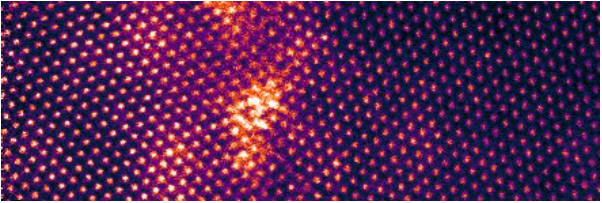
Characterizing defect phases at atomic scale
Two approaches have proven immensely successful in the design of new materials: thermodynamic description of crystalline phases, and manipulation of crystal defects. In the Collaborative Research Centre SFB1394 “Structural and Chemical Atomic Complexity: From Defect Phase Diagrams to Material Properties”, defects and their thermodynamic stability are brought together in the framework of defect phase diagrams.
Within the subproject B01, we have been studying surfaces and interfaces in model alloys and intermetallics. New defect phases at grain boundaries (GB) have been identified by aberration-corrected scanning transmission electron microscopy (STEM) [1, 2]. To trigger GB phase transformation, we systematically implanted Ga into a STEM sample containing a Σ7 [0001] (3120) tilt GB by focused ion beam [1]. As shown in Fig. 1, we traced the structural evolution of the GB and identified transformations of GB phases with different structures or Ga site occupation (chemical ordering). Based on the observed GB phase transformations, collaboration with atomistic simulation (Tilmann Hickel group) has enabled the construction of a defect phase diagram for this GB [1].
In addition to GB phases, atomic resolution microscopy has enabled us to understand chemical complexity in intermetallics [3], at stacking faults [4], interfaces [5] and surfaces [6-8]. We have developed a correlative STEM & atom probe tomography approach to image damage-free surfaces and the corrosion products on top [6, 7]. Within SFB1394, we continue to develop methods to characterize defect phases experimentally, as well as analyze them with mathematicians (Benjamin Berkels group) for automatic defect labelling and atomic site analysis [9].
![Figure 1: Defect phase transformation of a Mg Σ7 [0001] (3120) tilt GB triggered by Ga+ implantation and diffusion to tune the local chemical potential of Ga (µGa).](/5044006/original-1738936175.jpg?t=eyJ3aWR0aCI6MTM3OCwib2JqX2lkIjo1MDQ0MDA2fQ%3D%3D--a8fb27466b33df05deda8e40916d750b25aafa67)
Project publications
[1] Zhou, X.; Mathews, P.; Berkels, B.; Delis, W.; Saood, S.; Alhassan, A.; Keuter, P.; Schneider, J.M.; Korte-Kerzel, S.; Sandlöbes-Haut, S.; Raabe, D.; Neugebauer, J.; Dehm, G.; Hickel, T.; Scheu, C.; Zhang, S.
Materials Design by Constructing Phase Diagrams for Defects
Advanced Materials 2402191 (2024).
[2] Zhang, S.; Xie, Z.; Keuter, P.; Saood, S.; Abdellaoui, L.; Zhou, X.; Cautaerts, N.; Breitbach, B.; Aliramaji, S.; Korte-Kerzel, S.; Hans, M.; Schneider, J.M.; Scheu, C.
Atomistic structures of <0001> tilt grain boundaries in a textured Mg thin film
Nanoscale 14, 18192 (2022).
[3] Luo, W.; Xie, Z.; Zhang, S.; Guénolé, J.; Sun, P.; Meingast, A.; Alhassan, A.; Zhou, X.; Stein, F.; Pizzagalli, L.; Berkels, B.; Scheu, C.; Korte‐Kerzel, S.
Tailoring the Plasticity of Topologically Close‐packed Phases via the Crystals’ Fundamental Building Blocks
Advanced Materials 35, 2300586 (2023).
[4] Tehranchi, A.; Zhang, S.; Zendegani, A.; Scheu, C.; Hickel, T.; Neugebauer, J.
Metastable defect phase diagrams as roadmap to tailor chemically driven defect formation
Acta Materialia 277, 120145 (2024).
[5] Zubair, M.; Felten, M.; Hallstedt, B.; Vega Paredes, M.; Abdellaoui, L.; Bueno Villoro, R.; Lipinska-Chwalek, M.; Ayeb, N.; Springer, H.; Mayer, J.; Berkels, B.; Zander, D.; Korte-Kerzel, S.; Scheu, C.; Zhang, S.
Laves phases in Mg-Al-Ca alloys and their effect on mechanical properties
Materials & Design 225, 111470 (2023).
[6] Sasidhar, K.N.; Khanchandani, H.; Zhang, S.; Kwiatkowski da Silva, A.; Scheu, C.; Gault, B.; Ponge, D.; Raabe, D.
Understanding the protective ability of the native oxide on an Fe-13 at. % Cr alloy at the atomic scale: A combined atom probe and electron microscopy study
Corrosion Science 211, 110848 (2023).
[7] Neuß, D.; McCarroll, I.E.; Zhang, S.; Woods, E.; Delis, W.; Tanure, L.; Springer, H.; Sandlöbes, S.; Yang, J.; Todorova, M.; Zander, D.; Scheu, C.; Schneider, J.M.; Hans, M.
High-resolution chemical and structural characterization of the native oxide scale on a Mg-based alloy
Corrosion Science 227, 111776 (2024).
[8] Felten, M.; Chaineux, V.; Zhang, S.; Tehranchi, A.; Hickel, T.; Scheu, C.; Spille, J.; Lipińska-Chwałek, M.; Mayer, J.; Berkels, B.; Hans, M.; Greving, I.; Flenner, S.; Sefa, S.; Zander D.
The effect of Laves phases and nano-precipitates on the electrochemical corrosion resistance of Mg-Al-Ca alloys under alkaline conditions
Journal of Magnesium and Alloys 12, 2447 (2024).
[9] Alhassan, A.; Zhang, S.; Berkels, B.
Direct motif extraction from high resolution crystalline STEM images
Ultramicroscopy 254, 113827 (2024).
![Figure 1: Defect phase transformation of a Mg Σ7 [0001] (3120) tilt GB triggered by Ga+ implantation and diffusion to tune the local chemical potential of Ga (µGa). Figure 1: Defect phase transformation of a Mg Σ7 [0001] (3120) tilt GB triggered by Ga+ implantation and diffusion to tune the local chemical potential of Ga (µGa).](/5044006/original-1738936175.jpg?t=eyJ3aWR0aCI6ODQ4LCJmaWxlX2V4dGVuc2lvbiI6ImpwZyIsIm9ial9pZCI6NTA0NDAwNn0%3D--3ffe79d67148aee519e4215ce9921f40756e923a)